Related Research Articles

Corundum is a crystalline form of aluminium oxide typically containing traces of iron, titanium, vanadium, and chromium. It is a rock-forming mineral. It is a naturally transparent material, but can have different colors depending on the presence of transition metal impurities in its crystalline structure. Corundum has two primary gem varieties: ruby and sapphire. Rubies are red due to the presence of chromium, and sapphires exhibit a range of colors depending on what transition metal is present. A rare type of sapphire, padparadscha sapphire, is pink-orange.
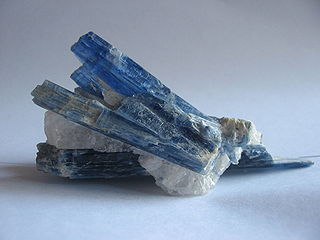
Kyanite is a typically blue aluminosilicate mineral, found in aluminium-rich metamorphic pegmatites and sedimentary rock. It is the high pressure polymorph of andalusite and sillimanite, and the presence of kyanite in metamorphic rocks generally indicates metamorphism deep in the Earth's crust. Kyanite is also known as disthene or cyanite.

Mineralogy is a subject of geology specializing in the scientific study of the chemistry, crystal structure, and physical properties of minerals and mineralized artifacts. Specific studies within mineralogy include the processes of mineral origin and formation, classification of minerals, their geographical distribution, as well as their utilization.
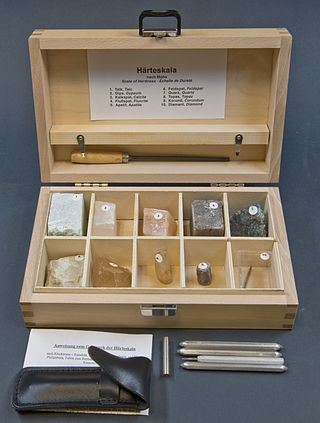
The Mohs scale of mineral hardness is a qualitative ordinal scale, from 1 to 10, characterizing scratch resistance of minerals through the ability of harder material to scratch softer material.
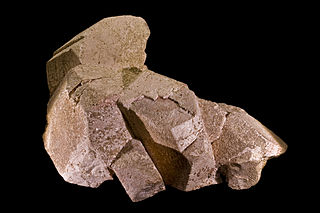
Orthoclase, or orthoclase feldspar (endmember formula KAlSi3O8), is an important tectosilicate mineral which forms igneous rock. The name is from the Ancient Greek for "straight fracture", because its two cleavage planes are at right angles to each other. It is a type of potassium feldspar, also known as K-feldspar. The gem known as moonstone (see below) is largely composed of orthoclase.

Carl Friedrich Christian Mohs was a German chemist and mineralogist. He was the creator of the Mohs scale of mineral hardness. Mohs also introduced a classification of the crystal forms in crystal systems independently of Christian Samuel Weiss.

Moissanite is naturally occurring silicon carbide and its various crystalline polymorphs. It has the chemical formula SiC and is a rare mineral, discovered by the French chemist Henri Moissan in 1893. Silicon carbide is useful for commercial and industrial applications due to its hardness, optical properties and thermal conductivity.

Allanite (also called orthite) is a sorosilicate group of minerals within the broader epidote group that contain a significant amount of rare-earth elements. The mineral occurs mainly in metamorphosed clay-rich sediments and felsic igneous rocks. It has the general formula A2M3Si3O12[OH], where the A sites can contain large cations such as Ca2+, Sr2+, and rare-earth elements, and the M sites admit Al3+, Fe3+, Mn3+, Fe2+, or Mg2+ among others. However, a large amount of additional elements, including Th, U, Be, Zr, P, Ba, Cr and others may be present in the mineral. The International Mineralogical Association lists four minerals in the allanite group, each recognized as a unique mineral: allanite-(Ce), allanite-(La), allanite-(Nd), and allanite-(Y), depending on the dominant rare earth present: cerium, lanthanum, neodymium or yttrium.
In materials science, hardness is a measure of the resistance to localized plastic deformation, such as an indentation or a scratch (linear), induced mechanically either by pressing or abrasion. In general, different materials differ in their hardness; for example hard metals such as titanium and beryllium are harder than soft metals such as sodium and metallic tin, or wood and common plastics. Macroscopic hardness is generally characterized by strong intermolecular bonds, but the behavior of solid materials under force is complex; therefore, hardness can be measured in different ways, such as scratch hardness, indentation hardness, and rebound hardness. Hardness is dependent on ductility, elastic stiffness, plasticity, strain, strength, toughness, viscoelasticity, and viscosity. Common examples of hard matter are ceramics, concrete, certain metals, and superhard materials, which can be contrasted with soft matter.

Lawsonite is a hydrous calcium aluminium sorosilicate mineral with formula CaAl2Si2O7(OH)2·H2O. Lawsonite crystallizes in the orthorhombic system in prismatic, often tabular crystals. Crystal twinning is common. It forms transparent to translucent colorless, white, pink, and bluish to pinkish grey glassy to greasy crystals. Refractive indices are nα=1.665, nβ=1.672 - 1.676, and nγ=1.684 - 1.686. It is typically almost colorless in thin section, but some lawsonite is pleochroic from colorless to pale yellow to pale blue, depending on orientation. The mineral has a Mohs hardness of 7.5 and a specific gravity of 3.09. It has perfect cleavage in two directions and a brittle fracture.
Jarosewichite is a rare manganese arsenate mineral with formula: Mn2+3Mn3+(AsO4)(OH)6. It was first described in Franklin, New Jersey which is its only reported occurrence. Its chemical composition and structure are similar to chlorophoenicite. This mineral is orthorhombic with 2/m2/m2/m point group. Its crystals are prismatic or barrel-shaped. The color of jarosewichite is dark red to black. It has subvitreous luster of fracture surfaces and reddish-orange streak. This mineral occurs with flinkite, franklinite, andradite and cahnite.

Osumilite is a very rare potassium-sodium-iron-magnesium-aluminium silicate mineral. Osumilite is part of the milarite group of cyclosilicates.
Scratch hardness refers to the hardness of a material in terms of resistance to scratches and abrasion by a harder material forcefully drawn over its surface. Scratch hardness test or scratch test refers to any of a number of methods of measuring scratch hardness. Resistance to abrasion is less affected by surface variations than indentation methods. Scratch hardness is measured with a sclerometer.
August Karl Rosiwal was an Austrian geologist.
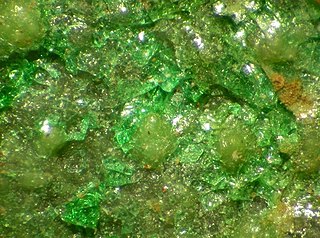
Widgiemoolthalite is a rare hydrated nickel(II) carbonate mineral with the chemical formula (Ni,Mg)5(CO3)4(OH)2·5H2O. Usually bluish-green in color, it is a brittle mineral formed during the weathering of nickel sulfide. Present on gaspéite surfaces, widgiemoolthalite has a Mohs scale hardness of 3.5 and an unknown though likely disordered crystal structure. Widgiemoolthalite was first discovered in 1992 in Widgiemooltha, Western Australia, which is to date its only known source. It was named the following year by the three researchers who first reported its existence, Ernest H. Nickel, Bruce W. Robinson, and William G. Mumme.
Lucabindiite is a mineral discovered in 1998 from the La Fossa crater at Vulcano, the Aeolian islands off the coast of Italy. It has the chemical formula As4O6(Cl,Br) and is hexagonal. After months of collecting sublimates and encrustations, the researchers discovered lucabindiite which was found on the surface of pyroclastic breccia. The mineral is named after Luca Bindi, who was a professor of mineralogy and former head of the Division of Mineralogy of the Natural History Museum of the University of Florence.
Hotsonite is a mineral with the formula ([[Al11(PO4)2(SO4)3(OH)21.16H2O]]. The name derived from the farm Hotson 42, located 65 km west of the town of Pofadder, in Bushmanland, northwestern Cape Province, South Africa. This is an arid region with an average rainfall of 3 inches per annum. The name was approved by the Commission on New Minerals and Mineral Names of the International Mineralogical Association (July 1983). It is chemically related to sanjuanite and kribergite.
Danielsite is a sulfide and sulfosalt that was first discovered in a pocket of supergene minerals in the north region of Western Australia. The location found was about 1 kilometre (0.62 mi) west of the locality known as Coppin Pool. The mineral danielsite was named after John L. Daniels who collected the sample in which the new mineral was found. The chemical formula of danielsite is (Cu,Ag)
14HgS
8. Danielsite is very fine grained and hard to observe in hand samples. It generally has a gray color with very brittle and soft physical characteristics.
Northstarite is an immensely rare lead-tellurite-thiosulfate mineral with an ideal formula of Pb6(Te4+ O3)5(S6+O3S2-). Northstarite was first discovered in 2019 by Charles Adan in the North Star Mine of the Tintic Mining District, Juab County, Utah, USA. Northstarite received its name after this type locality where it was originally discovered, the North Star Mine. Northstarite is the fourth thiosulfate mineral that exists on Earth, and although all thiosulfates have essential lead components, northstarite is the first thiosulfate species containing groups of both thiosulfate and tellurite (Te4+O3).
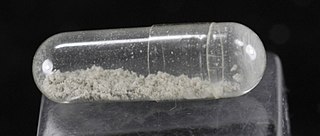
Kenyaite is a mineral and is a peculiar sodium silicate having a layered structure. It has a chemical formula of Na2Si22O41(OH)8 • 6H2O, which means it is made up of variations of different materials including sodium, silicon, hydrogen, and oxygen. The chemical composition of kenyaite is subject to change: when the interlayer of water has different variations; it undergoes different physical conditions; by partial to full exchange of the sodium ions by protons when kenyaite comes into contact with water. This is typical for intracrystalline reactive materials.
References
- ↑ Williams Postel, A.; Lufkin, H. M. (May 1942). "Additional Data on the Delesse-Rosiwal Method" (PDF). The American Mineralogist. 27 (5): 335–343.
- ↑ Larsen, Esper S.; Miller, Franklin S. (April 1935). "The Rosiwal Method and the Modal Determination of Rocks" (PDF). The American Mineralogist. 20 (4): 260–273.
Bibliography
- The Great Encyclopedia of minerals 451 photographs, 520 pages 20'5 x 29'2 cm. Original: Artia, Prague 1986 Catalan version: Editorial Susaeta SA 1989, ISBN 978-84-30515-85-1 (printed in Czechoslovakia)
- Accurate mineralogy. De Lapparent, A .: 1965 Paris
- Minerals and study how to Them. Dana L. Hurlbut, S .: New York 1949
- Schöne und seltene Mineral. Hofmann and F. Karpinski, J .: 1980 Leipzig
- CORDUANT, William S. "The Hardness of Minerals and Rocks". Lapidary Digest c. 1990.